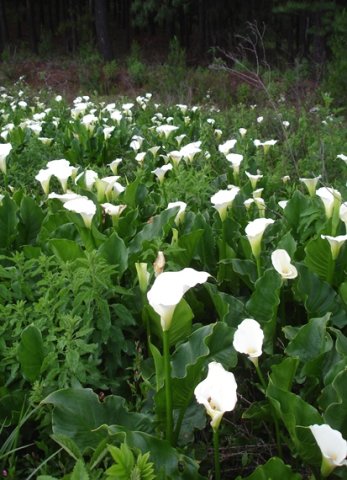Zantedeschia

Author: Ivan Lätti
Photographer: Judd Kirkel Welwitch
Zantedeschia is a genus of stemless perennials in the Araceae or arum lily family. These plants are not lilies and Arum is a separate genus in Araceae not indigenous in South Africa. Zantedeschia plants grow from rhizomes or disc-shaped tubers.
The leaves are simple and basal on long, erect, sometimes spongy petioles. The leaf-shapes range from lance-shaped, arrow-shaped and egg-shaped to rounded. The margins are entire, sometimes wavy. The smooth, hairless blade surfaces of some species are spotted.
The inflorescences appear concurrently with the leaves on long peduncles, as long as or longer than the leaves. The conspicuous petal-like structure of the inflorescence is a single spathe. The spathe is a modified leaf, funnel-shaped or cylindrical, its base reducing, folded or twisted. In some species there is a purple blotch in the base of the spathe. The limb of the spathe spreads obliquely, truncated or acutely pointed. Spathe colours are white, cream, yellow, pink or red.
The yellow, white or green spadix arising inside the spathe is sessile or stalked and shorter than the spathe. The spadix is covered in tiny male or pollen florets in its upper half and in female florets comprising ovaries, styles and stigmas in its lower half. All the florets lack perianths and are arranged in a complex spiral pattern. The oblong anthers higher up are sessile, without filaments, releasing pollen through pores at their tips. The white pollen is emitted in threads. Each ovary lower down has three locules containing ovules, topped by a short style and a head-like stigma.
The fruits that follow (on the bottom part of the spadix) are berries, each containing few to many seeds. The berries start off green, clustered on the axis of the spadix, often becoming orange when ripe. A berry cluster may then resemble a tiny pineapple but variably covered by the remains of its spathe. The seeds inside a berry are nearly spherical to egg-shaped, warty, moist and sticky.
There are eight Zantedeschia species, mostly occurring widespread in southern Africa to as far as Malawi. All eight are indigenous in South Africa but not found in the Northern Cape. The plants grow in marshes, near watercourses, in grassland and on rocky slopes, some in dry conditions, at elevations from sea level to around 2400 m.
The plants are popular as ornamentals, common in gardens worldwide. Early export records of plant parts from the Cape to Europe date back to the seventeenth century. Cultivars extend the looks of garden plants beyond those found in nature. At least Zantedeschia aethiopica is naturalised in some parts of the world, notably California. The tubers are cooked and eaten by people, while elephants and porcupines are known among the animals that also eat them. The leaves of some species feature in traditional medicine.
The plant in picture is Z. aethiopica (Leistner, (Ed.), 2000; Manning, 2009; Pooley, 1998; Letty, 1962; Wikipedia).

